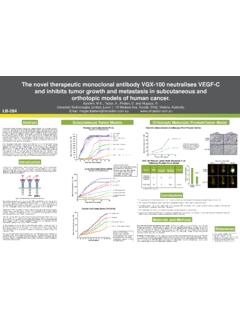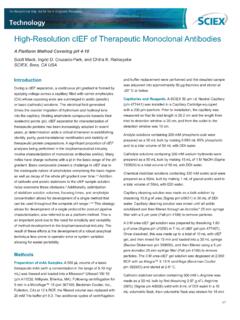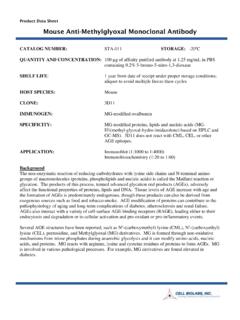Transcription of Guidelines on evaluation of monoclonal …
1 1 WHO/ 2 ENGLISH ONLY 3 4 Guidelines on evaluation of monoclonal antibodies as 5 similar biotherapeutic products (SBPs) 6 7 NOTE: 8 This document has been prepared for the purpose of inviting comments and suggestions on the 9 proposals contained therein, which will then be considered by the Expert Committee on 10 Biological Standardization (ECBS). Publication of this early draft is to provide information about 11 the proposed Guidelines on evaluation of monoclonal antibodies as similar biotherapeutic 12 products (SBPs) to a broad audience and to improve transparency of the consultation process.
2 13 14 The text in its present form does not necessarily represent an agreed formulation of the 15 Expert Committee. Written comments proposing modifications to this text MUST be 16 received by 16 September 2016 in the Comment Form available separately and should be 17 addressed to the World Health Organization, 1211 Geneva 27, Switzerland, attention: 18 Department of Essential Medicines and Health Products (EMP). Comments may also be 19 submitted electronically to the Responsible Officer: Dr Kai Gao at email: 20 21 The outcome of the deliberations of the Expert Committee will be published in the WHO 22 Technical Report Series.
3 The final agreed formulation of the document will be edited to be in 23 conformity with the "WHO style guide" (WHO/IMD/ ). 24 25 World Health Organization 2016 26 27 All rights reserved. Publications of the World Health Organization can be obtained from WHO Press, World Health Organization, 28 20 Avenue Appia, 1211 Geneva 27, Switzerland (tel.: +41 22 791 3264; fax: +41 22 791 4857; e-mail: 29 Requests for permission to reproduce or translate WHO publications whether for sale or for non-commercial distribution 30 should be addressed to WHO Press, at the above address (fax: +41 22 791 4806.))
4 E-mail: 31 32 The designations employed and the presentation of the material in this publication do not imply the expression of any opinion 33 whatsoever on the part of the World Health Organization concerning the legal status of any country, territory, city or area or of its 34 authorities, or concerning the delimitation of its frontiers or boundaries. Dotted lines on maps represent approximate border lines 35 for which there may not yet be full agreement. 36 37 The mention of specific companies or of certain manufacturers products does not imply that they are endorsed or recommended 38 by the World Health Organization in preference to others of a similar nature that are not mentioned.
5 Errors and omissions 39 excepted, the names of proprietary products are distinguished by initial capital letters. 40 41 All reasonable precautions have been taken by the World Health Organization to verify the information contained in this 42 publication. However, the published material is being distributed without warranty of any kind, either expressed or implied. The 43 responsibility for the interpretation and use of the material lies with the reader. In no event shall the World Health Organization be 44 liable for damages arising from its use. 45 46 The named authors [or editors as appropriate] alone are responsible for the views expressed in this publication.
6 47 WHO/ Page 2 Contents 1 1. Introduction .. 3 2 2. Scope .. 4 3 3. Glossary .. Error! Bookmark not defined. 4 4. Special considerations for characterization and quality assessment .. 7 5 5. Special considerations for nonclinial evaluation .. 10 6 6. Special considerations for clinical evaluation .. 14 7 Authors and acknowledgements .. 26 8 References .. 28 9 10 WHO/ Page 3 1. Introduction 1 monoclonal antibodies (mAbs) are a major class of recombinant deoxyribonucleic acid (rDNA) 2 technology-derived biotherapeutic products that have achieved outstanding success in treating 3 many life-threatening and chronic diseases.
7 Some of these targeted therapy products are ranked in 4 the top 10 lists of annual global pharmaceutical revenue successes. As patents and data protection 5 measures on mAb products have expired, or are nearing expiry, considerable attention has turned 6 towards producing similar biotherapeutic products (SBPs, also termed biosimilars) of the 7 approved mAb innovator products with a view to making more affordable products that may 8 improve global access to these so-called blockbusters . 9 10 mAbs for therapeutic use are preparations of an immunoglobulin or a fragment of an 11 immunoglobulin with specificity for a target ligand and derived from a single clone of cells.
8 Each 12 full-length molecule of an mAb consists of two heavy and two light polypeptide chains which are 13 linked by disulfide bonds. mAbs have several possible functional domains within a single 14 molecule. The defined specificity of a mAb is based on the binding region for an antigen that is 15 located in the Fab part. For full-length mAbs, their Fc region has the ability to bind to specific 16 receptors, leading to immune effector functions such as antibody-dependent cellular cytotoxicity 17 (ADCC) and complement-dependent cytotoxicity (CDC), etc. Full-length monoclonal antibodies 18 are glycoproteins with glycosylation sites in the Fc portion of the heavy chains, with further 19 glycosylation sites possible depending on the type of molecule.
9 Therefore, mAbs are highly 20 complex biological macromolecules with size and charge variants, various post-translational 21 modifications, including different glycosylation patterns, N and C terminal heterogeneity, long 22 half-lives and the potential for inducing immunogenicity. Each individual mAb may therefore 23 present a unique profile, which must be taken into consideration during the evaluation of these 24 products as biosimilars. 25 26 WHO s Guidelines on evaluation of similar biotherapeutic products (SBPs) were adopted by the 27 Expert Committee on Biological Standardization (ECBS) in 2009 (1).
10 This document provided 28 the scientific principles, including the stepwise approach, which should be applied for 29 demonstration of similarity between the SBP and the reference biotherapeutic product (RBP). 30 High similarity at the quality level is regarded as a prerequisite for enabling the use of a tailored 31 nonclinical and clinical data set for licensure. The goal of the clinical comparability exercise is to 32 confirm the similarity established at previous stages of development and to demonstrate that there 33 are no clinically meaningful differences between the SBP and the RBP, and not to re-establish 34 safety and efficacy because this has been done already for the RBP.
















